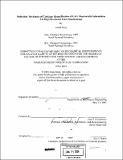| dc.contributor.advisor | Alan J. Grodzinsky. | en_US |
| dc.contributor.author | Seog, Joonil, 1969- | en_US |
| dc.contributor.other | Massachusetts Institute of Technology. Dept. of Mechanical Engineering. | en_US |
| dc.date.accessioned | 2005-06-02T16:31:14Z | |
| dc.date.available | 2005-06-02T16:31:14Z | |
| dc.date.copyright | 2003 | en_US |
| dc.date.issued | 2003 | en_US |
| dc.identifier.uri | http://hdl.handle.net/1721.1/17641 | |
| dc.description | Thesis (Sc. D.)--Massachusetts Institute of Technology, Dept. of Mechanical Engineering, 2003. | en_US |
| dc.description | Includes bibliographical references (leaves 121-135). | en_US |
| dc.description.abstract | Intermolecular repulsion forces between negatively charged glycosaminoglycan (CS-GAG) macromolecules are a major determinant of cartilage biomechanical properties. It is thought that the electrostatic component of the total intermolecular interaction is responsible for 50-75% of the equilibrium elastic modulus of cartilage in compression, while other forces (e.g., steric, hydration, van der Waals, etc.) may also play a role. To investigate these forces, radiolabeled CS-GAG polymer chains were chemically end-grafted to a planar surface to form model biomimetic polyelectrolyte "brush" layers whose environment was varied to mimic physiological conditions. The total intersurface force (<[or equal to] nN) between the CS-GAG brushes and chemically modified probe tips (SO₃⁻ and OH) was measured as a function of tip-substrate separation distance in aqueous solution using the technique of high-resolution force spectroscopy (HRFS). These experiments showed long-range, nonlinear, purely repulsive forces that decreased in magnitude and range with increasing ionic strength and decreasing pH. In order to estimate the contribution of the electrostatic component to the total intersurface force, the data were compared to a theoretical model of electrical double layer repulsion based on the Poisson-Boltzmann formulation. The CS-GAG brush layer was approximated as either a flat surface charge density or a smoothed volume of known fixed charge density and the probe tip was modeled as a smooth hemisphere of constant surface charge density. | en_US |
| dc.description.abstract | (cont.) To further closely mimic physiological condition of the cartilage, the CS-GAG molecules were successfully attached to the AFM probe tip using electric field. The CS-GAG modified tip was characterized by measuring force at various environments and its parking density was also estimated using newly developed molecular level model. The measured force between CS-GAG modified tip and CS-GAG modified substrate showed a long-range interaction that significantly dependent on the ionic strength and pH, indicating the significant role of Coulombic interaction between CS-GAG layers. The equilibrium brush height measured using ellipsometry showed that CS-GAG behaves as an annealed polyelectrolyte that reached its maximum brush height around 0.1 M salt concentration. The equilibrium brush height was compared with the onset of the force increase to obtain further insight on the CS-GAG brush behavior during the force measurement. | en_US |
| dc.description.statementofresponsibility | by Joonil Seog. | en_US |
| dc.format.extent | 135 leaves | en_US |
| dc.format.extent | 6143564 bytes | |
| dc.format.extent | 6143373 bytes | |
| dc.format.mimetype | application/pdf | |
| dc.format.mimetype | application/pdf | |
| dc.language.iso | eng | en_US |
| dc.publisher | Massachusetts Institute of Technology | en_US |
| dc.rights | M.I.T. theses are protected by copyright. They may be viewed from this source for any purpose, but reproduction or distribution in any format is prohibited without written permission. See provided URL for inquiries about permission. | en_US |
| dc.rights.uri | http://dspace.mit.edu/handle/1721.1/7582 | |
| dc.subject | Mechanical Engineering. | en_US |
| dc.title | Molecular mechanics of cartilage : quantification of GAG electrostatic interactions via high-resolution force spectroscopy | en_US |
| dc.type | Thesis | en_US |
| dc.description.degree | Sc.D. | en_US |
| dc.contributor.department | Massachusetts Institute of Technology. Department of Mechanical Engineering | |
| dc.identifier.oclc | 54853954 | en_US |
